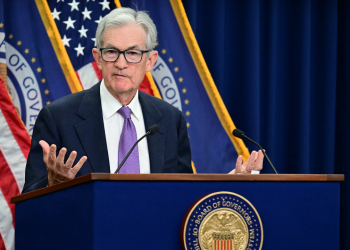By John Kemp
LONDON (Reuters) – U.S. service-sector businesses returned to steady expansion in the third quarter after a brief and scarcely perceptible slowdown in the second quarter, according to business surveys.
But the expansion is fuelling faster price increases, putting the central bank’s disinflation plan in jeopardy and will likely lead to interest rates remaining higher for longer.
In turn, higher rates will dampen interest-sensitive expenditure and likely lead to slower growth in oil consumption in 2024.
Higher-for-longer rates will hit marginal borrowers in the United States, Europe and emerging markets especially hard.
The Institute for Supply Management’s services activity index was at 53.6 (29th percentile for all months since 1997) in September up from a low of 50.3 (11th percentile) in May.
In contrast to the manufacturing sector, which has experienced a long but relatively shallow business cycle downturn, the much larger service sector has barely experienced a downturn at all.
Chartbook: U.S. service sector
Renewed expansion has ensured service providers have enough pricing power to push through further price rises after pricing power faltered briefly in the second quarter.
Service-sector prices increased at an annualised rate of 5.2% over the three months ending in September, up from 3.3% in the three months ending in June.
The acceleration in service-sector price increases was broadly based and similar whether housing rents are included or excluded.
Service-sector prices are rising more than twice as fast as the central bank’s whole-economy flexible average inflation target of a little over 2%.
Services are less energy-intensive but more labour-intensive than manufacturing, so the sector’s inflation rate tends to be more persistent and a better indicator of the overall amount of inflationary pressure within the economy.
There are 112 million people on the payrolls of private-sector services firms compared with 13 million employed by manufacturers.
HIGHER FOR LONGER
Inflationary pressures have persisted despite the fall in oil, gas and some other raw materials prices from their highs in early to mid-2022 in the aftermath of the pandemic and Russia’s invasion of Ukraine.
Prices have also continued to escalate despite the central bank increasing overnight interest rates by 525 basis points between March 2022 and July 2023.
Real rates have only become positive in the last few months, however, and even then they are scarcely higher than most measures of inflation.
With most actual borrowing rates fixed for multiple years, rather than tracking the overnight rate, the increase in borrowing costs has only affected a minority of households and businesses so far.
But the longer interest rates remain high, the greater the number of households and firms eventually affected by them when they need new credit or to refinance maturing loans.
The full impact of the interest-rate increases so far will continue to filter through and hit interest-sensitive spending over the course of 2024.
Most rate traders anticipate the central bank will be forced to keep overnight rates higher for longer to squeeze persistent inflation out of the economy.
Based on futures prices, the Federal Reserve is not expected to cut interest rates from their current level of 5.25%-5.50% until the middle of 2024.
Rates are still expected to be as high as 4.50%-4.75% at the end of 2024. Previously, during the second-quarter slowdown, rates were expected to fall to as little as 3.00%-3.25% by the end of 2024.
The impact of higher-for-longer rates on overall borrowing costs is encapsulated in the rise in yields on long-term U.S Treasury securities which act as the benchmark for other borrowers.
Yields on 10-year notes have climbed to more than 4.60% from less than 3.50% at the end of April amid the brief slowdown.
In the short term, the renewed expansion of the U.S. manufacturing and service sectors is supporting oil consumption and prices.
In the medium term, however, the higher-for-longer rates needed to bring inflation back to target will likely depress business activity and slow oil consumption growth in 2024.
The central bank’s tentativeness about raising rates further may have spared the economy a hard landing in 2023 – in fact there may not have been any landing at all.
But it seems likely that some of the pain has simply been postponed until next year.
Related columns:
– U.S. manufacturing rebound will stretch diesel supplies (October 5, 2023)
– Cromwell’s rule and the global economic outlook (May 10, 2023)
John Kemp is a Reuters market analyst. The views expressed are his own
Read the full article here









